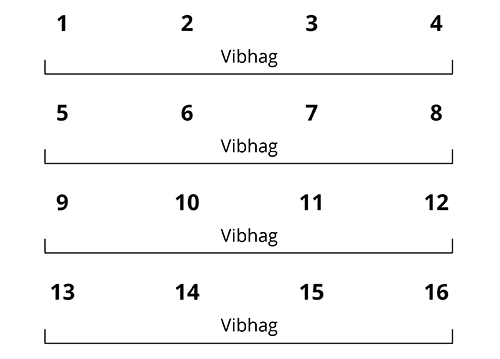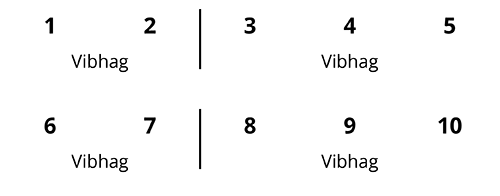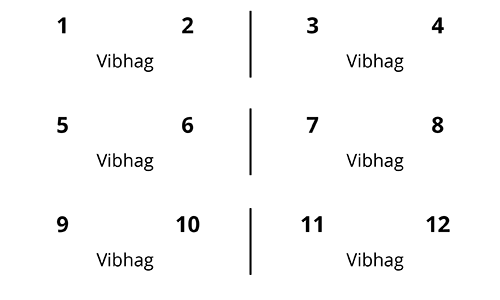Vibhāg – विभाग
Quick Definition: The divisions of matras (beats) in a tal.
Literal Meaning: division; unit; block
Example of Vibhags in Tintal:

Introduction to Vibhag
The matras (beats) in every tal are grouped into divisions called vibhags. In the example of tintal above, we see the tal’s 16 matras divided into 4 vibhags of 4 matras each.
The vibhags organize the matras and create a particular pattern of divisions. With vibhags, we start to see the rhythmic structure of a tal.
Vibhags have the following general characteristics:
- Most tals have between 2 and 6 vibhags (every tal has at least 2).
- Most vibhags are between 2 and 4 matras long.
- All vibhags are either stressed (tali) or unstressed (khali) (discussed in the next section).
Examples of Vibhag Structures in Other Tals
Above we saw the vibhag structure for tintal (4-4-4-4). Below are the vibhag structures for a few other tals:
Jhaptal: 10 matras divided into four vibhags (2–3–2–3):

Rupak Tal: 7 matras divided into three vibhags (3–2–2):

Ektal: 12 matras divided into six vibhags (2–2–2–2-2-2):

See the Extended List of North Indians Tals and Thekas to see a wide variety of vibhag structures.
Vibhags help musicians to know where they are in the tal
Some tals are long—12, 14, or 16 matras, for example—and are sometimes performed at slow tempos. The vibhags make it easier for musicians to know where they are in the tal.
In tintal, for example, musicians will not normally count from 1 to 16 as they play, but can count—or feel—in groups of 4 matras (4–4–4–4).
And musicians performing in jhaptal will not simply count from 1 to 10, but can follow the vibhags of 2–3–2–3.
Vibhags create a general rhythmic structure
The vibhags in a tal form a general structure such as we saw above in tintal (4–4–4–4), jhaptal (2–3–2–3), rupak tal (3–2–2), and ektal (2–2–2–2). These structures help to create a tal’s unique character.
For example, jhaptal and sultal both have 10 matras. But their vibhags are divided differently; jhaptal is divided 2–3–2–3 and sultal is divided 2–2–2–2–2:
Jhaptal Vibhags:

Sultal Vibhags:

However, the vibhags in a tal are not equal. As we will see in the next section, all vibhags are either tali or khali (stressed or unstressed), adding yet another level of structure to the tal.
References
Clayton, Martin. Time in Indian Music: Rhythm, Metre, and Form in North Indian Rāg Performance. Oxford: Oxford University Press, 2000.
Misra, Chhote Lal. Tal Prasoon. New Delhi: Kanishka Publishers, 2004. (Hindi)
Stewart, Rebecca Marie. The Tabla in Perspective. Unpublished Ph.D. thesis, University of California, Los Angeles, 1974.